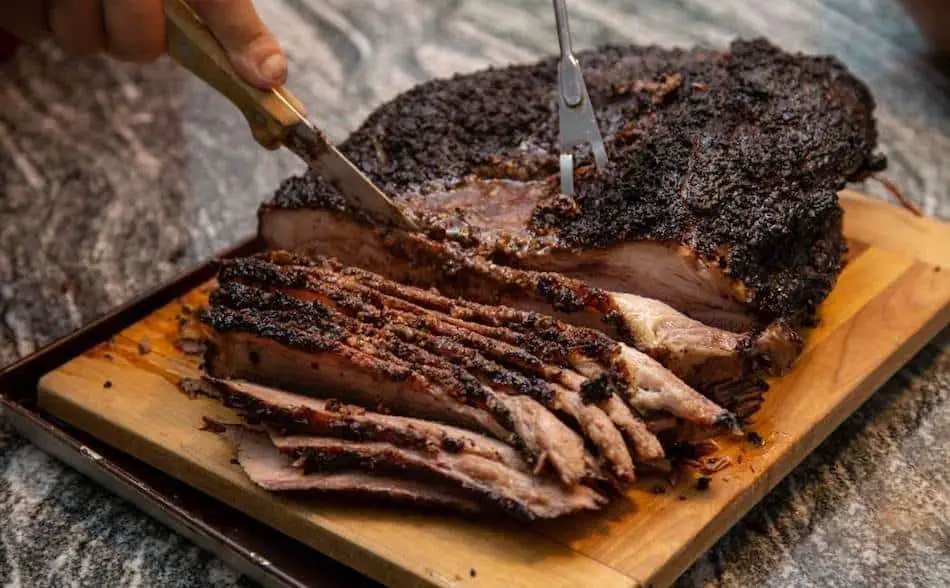
Brisket is a tough, flavorful cut of meat that requires careful cooking to achieve tender, juicy results. If you want tender brisket, there are several techniques you can use to get good results. In this article, I’ll show you how barbecue champions smoke brisket. You’ll learn all the tips and techniques to get succulant brisket every time you fire up your smoker.
Achieving a tender and juicy brisket requires using a high-quality cut of meat with good marbling and trimming off any excess fat before cooking. The cooking process should involve cooking the brisket slowly over low heat, using indirect heat and allowing plenty of time for the connective tissue to break down and the fat to render. Adding a flavorful rub or marinade can also enhance the finished product. Allowing the brisket to rest after cooking allows the juices to redistribute, and slicing the brisket against the grain maximizes tenderness. By following these key steps, it is possible to achieve a tender and juicy brisket every time.
Key Points
| Key Point | Description |
|---|---|
| Cook low and slow | To tenderize a brisket, it needs to be cooked at low temperatures for an extended period of time to break down the tough connective tissue. |
| Maintain temperature | The temperature of the smoker should be maintained between 225°F and 250°F for the best results. |
| Cook to an internal temperature | The brisket should be cooked to an internal temperature of 203°F to be probe tender. |
| Use wrapping techniques | Wrapping the brisket in foil or butcher paper can help to tenderize the meat and trap moisture. |
| Inject with marinade | Injecting the brisket with marinade can help to add moisture and flavor to the meat. |
| Use a spritz or mop | Spritzing or mopping the meat can help to slow down the cooking process and keep the meat moist. |
| Buy quality meat | Buying high quality beef with marbling is important for tender, juicy brisket. |
| Allow the brisket to rest | After cooking, allow the brisket to rest for at least 30 minutes to allow the juices to redistribute and improve the overall texture and flavor of the meat. |
What the Experts Say
Achieving tender, juicy brisket is a goal for many barbecue enthusiasts, and there are a few key factors that pitmasters and experts agree on when it comes to achieving this sought-after result.
First and foremost, it’s important to use a high-quality cut of meat with good marbling. As BBQ pitmaster Myron Mixon advises, “The key to a great brisket is a good marbling of fat throughout the meat, as well as a good smoke ring.” Trimming off any excess fat before cooking can also help ensure a tender, juicy end result.
The cooking process is also crucial in achieving tender and juicy brisket. As BBQ pitmaster Aaron Franklin advises, it’s important to “cook the brisket low and slow, using indirect heat and allowing plenty of time for the connective tissue to break down and the fat to render.” BBQ pitmaster Melissa Cookston agrees, adding that using a flavorful rub or marinade can also add depth of flavor to the finished product.
“The key to a great brisket is a good marbling of fat throughout the meat, as well as a good smoke ring. To get a tender brisket, make sure to slice it against the grain and always use a sharp knife.”
– Myron Mixon, BBQ pitmaster and author
Finally, it’s important to slice the brisket against the grain for maximum tenderness. As BBQ expert Steven Raichlen advises, “the key is to cook the brisket slowly over low heat, using indirect heat and allowing plenty of time for the connective tissue to break down and the fat to render.” BBQ pitmaster Tuffy Stone adds that it’s also crucial to “allow the brisket to rest after cooking to let the juices redistribute throughout the meat.”
With the right cut of meat and proper cooking techniques, you can achieve a tender and juicy brisket every time. As BBQ pitmaster Dave Anderson advises, “with the right cut of meat and proper cooking techniques, you can achieve a tender and juicy brisket every time.” So next time you’re firing up the grill, keep these tips in mind for a mouthwatering, tender and juicy brisket.
Why is Brisket Tough?
Brisket is a tough hard-working muscle from the four-quarter of the animal with a large amount of connective tissue. Tough cuts of meat like brisket need to be cooked at low temperatures, otherwise the meat will be too chewy. The only way to break down the connective tissue is to cook it slow.
Traditional roasting instructs us to cook according to time. Low-and-slow cooking, where tenderness is paramount, we cook to internal temperature rather than time. The connective tissue is also the reason brisket is so delicious when cooked correctly. The fat and connective tissue turns into a delicious gelatin-like texture when it melts. We all know fat equals flavor, and brisket has a lot of intramuscular fat, which gives it the wonderful flavor.
“Achieving tender, juicy brisket is all about the cooking process. It’s important to cook the brisket low and slow, using indirect heat and allowing plenty of time for the connective tissue to break down and the fat to render. Additionally, it’s important to use a good quality, well-marbled cut of meat, as well as a flavorful rub or marinade to add depth of flavor.”
– Aaron Franklin, owner of Franklin Barbecue and author
To tenderize a brisket, it is important to cook it at low a temperature for an extended period of time. Brisket contains a lot of fatty connective tissue that needs to be broken down, and this process is achieved through slow cooking. To ensure that the brisket is cooked to the optimal tenderness, it is important to maintain the temperature of the smoker between 225°F and 250°F.
When done, the internal temperature of the meat should be measured using a meat thermometer and cooked to at least 203°F to be considered probe tender. There are also a number of tenderness tests that you can perform to ensure the brisket is tender.
1. Wrap Your Brisket In Foil or Butcher Paper
Wrapping your brisket plays in important role in the smoking process. It will help tenderize the meat, and it will trap moisture inside. There are two common wrappings. The most common is aluminium foil, and the other wrap is butcher paper (popularized by Aaron Franklin). Both types of wrapping will make the brisket taste slightly different, and they will give the brisket a different texture. Butcher paper allows the brisket to breathe, so the bark will end up crispier. As Aaron Franklin says, foil will give the brisket more of a pot roasty taste.
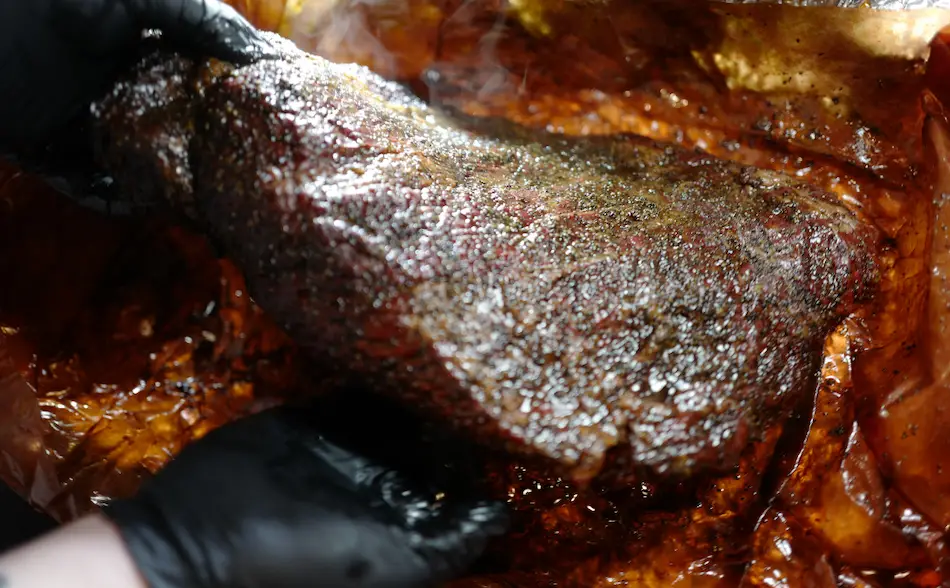
2. Inject Your Brisket With Marinade
Injecting your brisket is a great way to tenderize the meat. By injecting a needle into the brisket and pumping it with marinade is one of the few ways to get moisture and salt into the center of the brisket. There are several great products on the market, marinades that are used in barbecue competitions by professionals. Butcher BBQ is the most popular and one of the few products available on Amazon.
Meat injectors are inexpensive and you can get them on Amazon for about $30 or $40. You can use broth or stock to inject the meat, or salted butter, or any other ingredient you might find. I’ve written a full article and how to inject a brisket and you can check it out here.
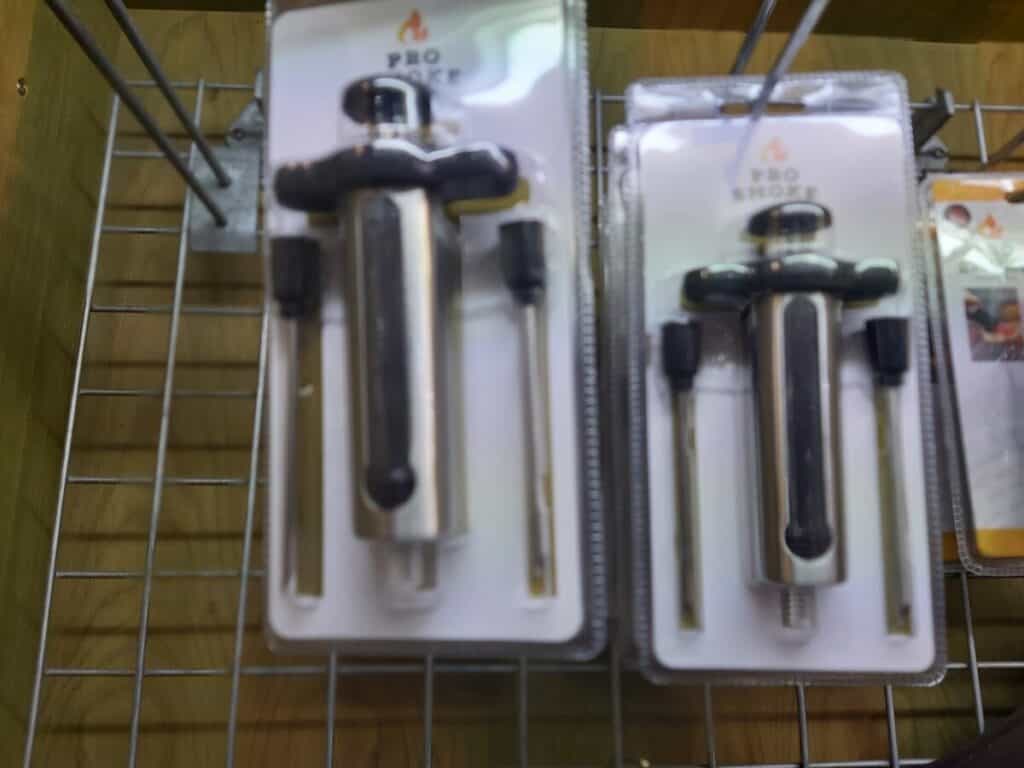
This brisket injection marinade is the secret used in competitions and made by a World Barbecue champion.
3. Keep The Temperature Low
The best way to tenderize your brisket is to keep the temperature nice and low. If you cook the meat too fast, or if the temperature exceeds 275°F, then don’t expect a tender, juicy brisket. The ideal cooking temperature for brisket is between 225°F and 275°F. To be safe, I recommend keeping it in the lower range unless you have a good handle on the brisket fundamentals. Also, if you are smoking a low-grade beef, I would keep the temperature at 225°F.
“The most important factor in creating a tender and juicy brisket is the quality of the meat. Look for a brisket with a good amount of marbling and make sure to trim off any excess fat before cooking. The cooking process is also crucial – use a low temperature and cook the brisket until it’s tender and easily pulls apart. Finally, make sure to slice the brisket against the grain for maximum tenderness.”
– Melissa Cookston, BBQ pitmaster and author
4. Spritz The Brisket To Slow Down The Cook
The key to smoking a tender brisket is to keep the meat at a low temperature for a long period. Spritzing or mopping the meat will slow down the cook. Wetting the meat will have a cooling effect, slowing down the total cook time, which is what you want. The longer the brisket can sit at that low temperature, the better.
To spritz your brisket, buy a spray bottle and fill it with apple cider vinegar or apple juice. You can also use beer, wine or any other suitable liquid. Spritz the brisket every hour during the first phase of the cook. However, don’t spritz the meat too early. For the first few hours of the cook, just leave the brisket alone, giving it time to absorb the smoke and keep the temperature of your smoker stable. I’ve written a full article on spritzing brisket and you can check it out here.
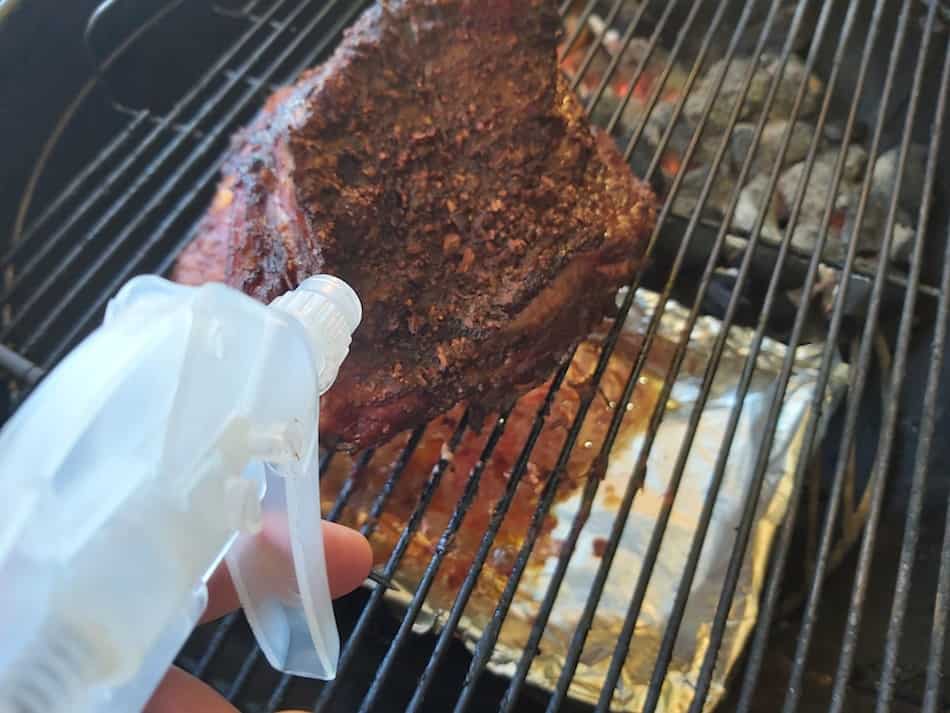
5. Buy Higher Quality Beef Grade
- Beef grade is a classification system that determines the quality and flavor of beef
- There are three main grades of beef: Prime, Choice, and Select
- Prime and Choice grades are generally more tender and flavorful than Select
- Higher grade beef is usually from younger animals with more marbling, which can make the meat more tender
- To make tender brisket, it is recommended to use a high-grade beef, such as Prime or Choice
- If using a lower grade beef, such as Select, additional techniques, like marinating or injecting, may be needed to help tenderize the meat
When it comes to tender brisket, beef grade is important because it can affect the texture and flavor of the meat. Higher grade beef, such as Prime or Choice, tends to be more tender and flavorful than lower grade beef, such as Select. This is because higher grade beef is typically from younger animals with more marbling, which can make the meat more tender and flavorful.
Beef grade is a classification system that is used to determine the quality and flavor of beef. There are several different grades of beef, including Prime, Choice, and Select. The grade of beef is determined based on factors such as the age of the animal, the amount of marbling (fat within the muscle), and the overall condition of the meat.
To ensure a tender brisket, it is generally recommended to use a high-grade beef. Prime and Choice grades are usually the best options for brisket, as they tend to be the most tender and flavorful. If you are using a lower grade beef, such as Select, you may need to use additional techniques, such as marinating or injecting the meat, to help tenderize it.
6. Use a Quality Meat Thermometer
- A good meat thermometer is essential for smoking brisket
- Without a thermometer, you’re cooking blind
- A wireless thermometer comes with one or two probes that can be inserted into the meat
- Using a thermometer allows for precision cooking, rather than relying on time estimates
- There are a range of options available on the market, with prices ranging from $50 to $300
- High-tech thermometers may offer features such as Wi-Fi connectivity and phone control
When you’re smoking brisket, a good meat thermometer is a must. It’s the best way to know how your brisket is cooking on the inside. A wireless thermometer comes with one or two probes that you can stick into the meat to track the internal temperature inside the meat while it’s cooking. This is how barbecue pros cook with such precision. When it comes to brisket, a thermometer will be your guide. There’s dozens of good thermometers on the market. They range from $50 to over $300. I’ve used the TP20 for years, and it only cost me $50 on Amazon.
“To get a tender and juicy brisket, it’s important to use a high-quality cut of meat and cook it slowly over low heat. It’s also crucial to allow the brisket to rest after cooking to let the juices redistribute throughout the meat. Finally, make sure to slice the brisket against the grain for maximum tenderness.”
– Ardie Davis, BBQ pitmaster and author
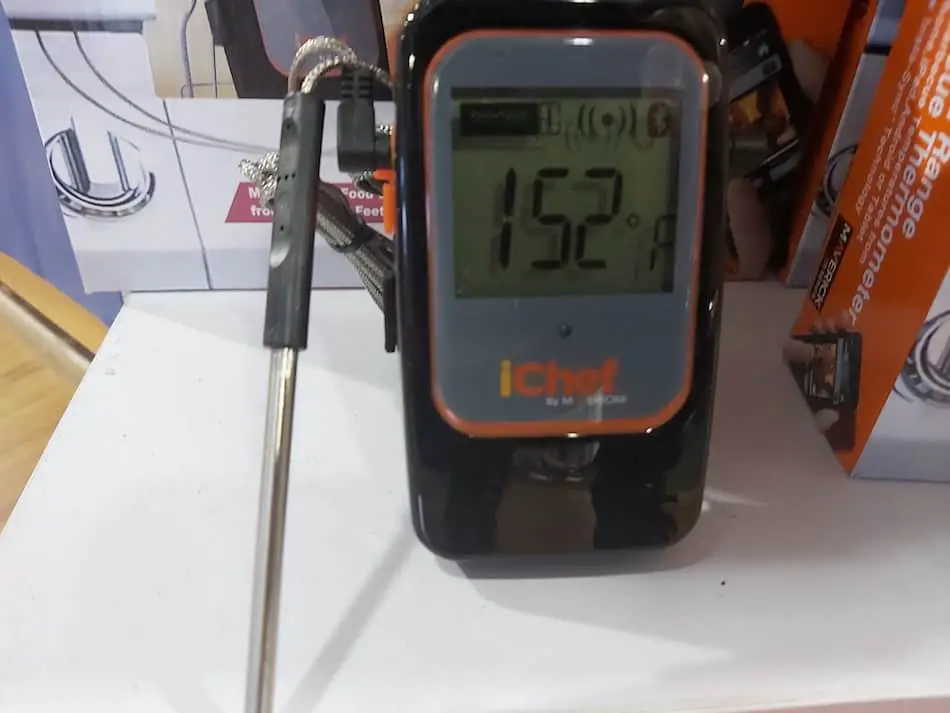
7. Learn To Test For Tenderness
There are several ways to test for brisket tenderness, and it’s important to choose the method that works best for you. Here are some options:
- Probe tenderness test: This is a common method for testing the tenderness of a brisket. To perform the probe tenderness test, you will need a meat thermometer with a probe. Simply insert the probe into the thickest part of the brisket, being careful not to touch the bone. The probe should easily slide into the meat without any resistance. If the probe goes in easily, the brisket is considered probe tender.
- The “poke test”: Another way to test for brisket tenderness is the “poke test.” To perform the poke test, simply press your finger gently into the surface of the brisket. If the surface springs back quickly, the brisket is likely not yet tender. If the surface stays indented for a few seconds before slowly returning to its original shape, the brisket is probably tender.
- The “pull test”: Another method for testing brisket tenderness is the “pull test.” To perform the pull test, gently pull on the end of the brisket with a pair of tongs or a fork. If the meat pulls apart easily, it is likely tender. If the meat is tough and resists pulling, it may need more time to cook.
- Visual inspection: Finally, you can also test for brisket tenderness by visually inspecting the meat. If the meat is tender, it should be moist and have a tender, succulent appearance. If the meat is dry or looks tough, it may need more time to cook.
No matter which method you choose, it is important to remember that brisket is a tough cut of meat that requires slow cooking to become tender. By using one of these methods to test for tenderness, you can ensure that your brisket is perfectly cooked every time.
“The secret to a tender and juicy brisket is all in the cooking process. It’s important to cook the brisket slowly over low heat, using indirect heat and allowing plenty of time for the connective tissue to break down and the fat to render. Additionally, it’s important to use a good quality, well-marbled cut of meat, as well as a flavorful rub or marinade to add depth of flavor. Finally, make sure to slice the brisket against the grain for maximum tenderness.”
– Steven Raichlen, BBQ expert and author
8. Hold Your Brisket in a Cooler
Holding a brisket after it has been removed from the smoker is a great way to make it even more tender. When you hold a brisket, you are allowing it to continue cooking at a low temperature for an extended period of time. This helps to break down the tough connective tissue and make the meat more tender.
To hold a brisket, first wrap it in foil or butcher paper. This will help to keep the meat moist and prevent it from drying out. Next, place the wrapped brisket in a dry cooler. By placing the wrapped brisket in a dry cooler, you can keep it hot for several hours. This will allow the brisket to continue cooking and tenderizing.
It’s important to note that the longer you hold a brisket, the more tender it will become. Some people even hold their brisket for up to 8 hours or more! Just be sure to check the temperature of the meat regularly to ensure that it stays safe to eat. Keep your thermometer inserted into the brisket so you can continue to monitor the internal temperature.
Check out this article: Resting Brisket In A Cooler
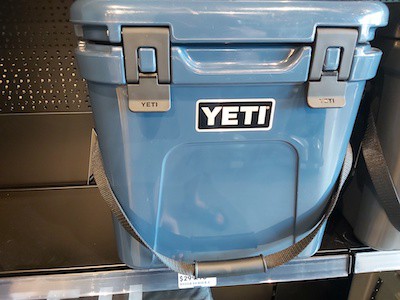
9. Slice Against the Grain
Slicing a brisket against the grain means cutting the meat in a direction that is perpendicular to the direction of the muscle fibers. When you slice a brisket against the grain, you are cutting the meat into smaller pieces that are easier to chew. This can make the meat seem more tender and easier to eat.
To slice a brisket against the grain, start by identifying the direction of the muscle fibers. You can do this by looking at the surface of the brisket and noticing which way the fibers are running. Once you have identified the direction of the fibers, place the brisket on a cutting board and slice it in the opposite direction.
“Achieving a tender and juicy brisket requires patience and a bit of know-how. The key is to cook the brisket slowly over low heat, using indirect heat and allowing plenty of time for the connective tissue to break down and the fat to render. Additionally, it’s important to use a good quality, well-marbled cut of meat and to apply a flavorful rub or marinade to add depth of flavor. Finally, make sure to slice the brisket against the grain for maximum tenderness.”
– Tuffy Stone, BBQ pitmaster and owner of Q Barbeque
Slicing a brisket against the grain is a useful technique for making the meat more tender because it breaks down the muscle fibers into smaller pieces. When you cut a brisket with the grain, you are cutting through the fibers, which can make the meat seem tougher and more difficult to chew. By slicing against the grain, you are cutting across the fibers, which can make the meat seem more tender and easier to eat.
It’s important to note that slicing a brisket against the grain is not the only way to make the meat more tender. There are other techniques, such as cooking the meat slowly at a low temperature and using a marinade or rub, that can also help to tenderize the meat. By using a combination of these techniques, you can achieve a perfectly tender, juicy brisket every time.
10. Rest Your Brisket
Resting a brisket means allowing it to sit at room temperature for a period of time after it has been cooked. Resting a brisket is an important step in the cooking process because it allows the juices to redistribute throughout the meat.
When a brisket is cooked, the juices within the meat start to move towards the center of the cut. This is because the heat causes the muscles to contract, which pushes the juices towards the center. If you slice a brisket immediately after it has been cooked, the juices will flow out of the meat and onto the cutting board, leaving the meat dry and tough.
By allowing the brisket to rest, you give the juices a chance to redistribute throughout the meat. This helps to keep the meat moist and tender, as the juices help to keep the meat hydrated. Resting a brisket also allows the muscles to relax, which can help to make the meat more tender and easier to slice.
“The most important factor in creating a tender and juicy brisket is the quality of the meat. Look for a brisket with a good amount of marbling and make sure to trim off any excess fat before cooking. The cooking process is also crucial – use a low temperature and cook the brisket until it’s tender and easily pulls apart. Finally, make sure to slice the brisket against the grain for maximum tenderness. With the right cut of meat and proper cooking techniques, you can achieve a tender and juicy brisket every time.”
– Dave Anderson, BBQ pitmaster and owner of BBQ Dave’s
Try Finish Your Brisket in the Oven
If you want to finish cooking your brisket in the oven, you can do so after the meat has reached the wrapping stage. The brisket is already smoked at this stage, so all you need to do is cook until it reaches tenderness. Finishing a brisket in the oven means you to close your smoker and go inside. This will help you save fuel, especially since pellets, wood, and charcoal can be expensive.
Preheat your oven to 250°F, then place the wrapped brisket in a roasting pan. Keep a thermometer inserted into the meat and continue the cook until it reaches an internal temperature of 203°F. This may take several hours, depending on the size of the brisket. Don’t just rely on temperature, but also check for tenderness.
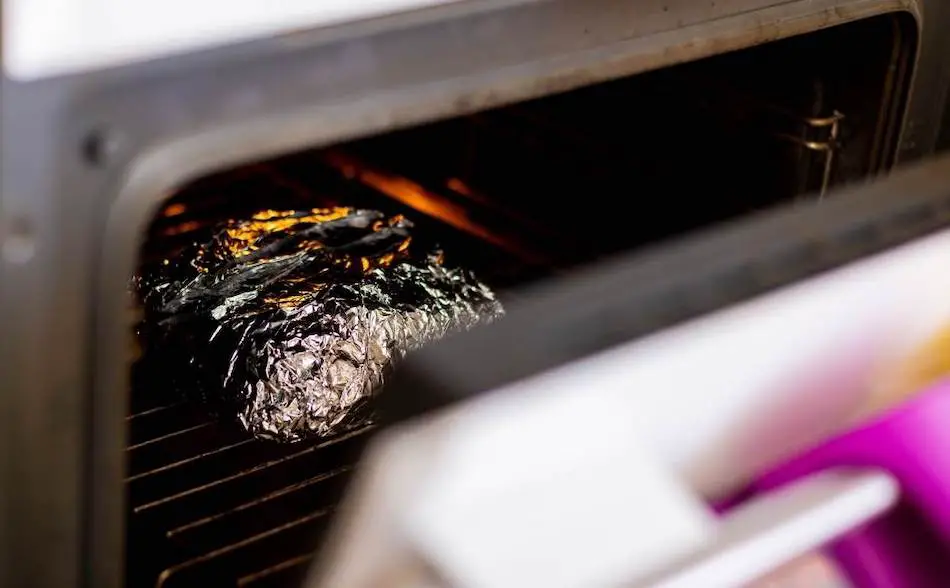
Brisket Planner
Planning brisket can be a nightmare, especially if you need it done by a certain time. You can partially cook your brisket, and finish it the next day, but it won’t turn out as good. I’ve written a full article on this, and you can read it here. Here is a basic brisket planner where it shows you when to wrap, and when to remove and when to spritz, etc.
| Brisket Total Cook Time | Start Time | Begin Spritzing | Wrap Brisket | Finish in Oven | Done Time (203°F) | Holding Time In Dry Cooler (1-4 hours) |
| 12 hours | 6pm | 9pm | 12am | 12am | 6am | Between 7am – 10am |
| 15 hours | 5pm | 8pm | 11pm | 11pm | 8am | Between 9am – 12pm |
| 18 hours | 2pm | 5pm | 8pm | 8pm | 8am | Between 9am- 12pm |
Brisket Leftovers
There are a few ways to restore your brisket leftovers, so they are almost as good as they were after you sliced it fresh out of the smoker. If you have a vacuum packaging machine, vacuum your leftover brisket as an entire piece and put it in the refrigerator for about 2 weeks, or into the freezer for an extended period. When it’s time to reheat your brisket leftovers, place the bag into sous-vide bath, or onto a pot of water and bring it up to temperature at a very low heat. Check out my article on sous-vide brisket to find out more about this French cooking method that has taken the barbecue world by storm.
Smoked Brisket

Tender, juicy smoked brisket cooked low and slow on a smoker.
Ingredients
- Brisket
- Barbecue rub
- Kosher salt ( for the dry brine)
- Yellow mustard or olive oil ( for the binder)
Instructions
1. Select a brisket with good marbling.
2. Trim the fat but leave 1/4 inch of fat on top.
3. Dry brine the brisket by sprinkling kosher salt on both sides of the meat and refrigerate for a few hours or overnight.
4. Inject the brisket with broth or marinade. * Optional
5. Slather the brisket with olive oil or yellow mustard. *Optional
6. Apply an even layer barbeque rub. If the rub contains salt, skip the dry brine step.
7. Use hickory, oak, pecan or your favorite smoking wood.
8. Set the temperature of your smoker between 225°F to 250°F
9. Place the brisket in smoker away from the heat source.
10. Fill the water pan with hot water.
11. Insert a leave-in meat thermometer into the brisket.
12. Leave the brisket alone for the first 3 hours or so. Allow the brisket to absorb smoke and develop a bark.
13. Once the rub has fused to the meat, begin to spritz the brisket every hour with either apple juice, broth, apple cider vinegar or beer. Otherwise, mop with a mop sauce.
14. Once the bark is firm, wrap the brisket in foil or butcher paper. By this stage, the meat should have reached an internal temperature between 150°F and 160°F.
15. Insert the thermometer into the meat and place the brisket back in the smoker.
16. Continue cooking until the brisket is tender as butter when poked with a toothpick or probe. The internal meat temperature should read somewhere between 195°F and 203°F when perfectly tender.
17. Allow the meat to rest for about 1 hour before slicing. If you're not ready to serve, place the brisket into a dry cooler. Keep the brisket wrapped in foil or butcher paper, then wrap again with a towel or dish cloth. The brisket will remain hot for over 4 hours. Keep a thermometer probe inserted.
18. Slice against the grain and serve.
Nutrition Information:
Serving Size:
85 gramsAmount Per Serving: Calories: 246 grams
In Summary
- Cook low and slow: To tenderize a brisket, it needs to be cooked at low temperatures for an extended period of time to break down the tough connective tissue.
- Maintain temperature: The temperature of the smoker should be maintained between 225°F and 250°F for the best results.
- Cook to an internal temperature: The brisket should be cooked to an internal temperature of 203°F to be probe tender.
- Use wrapping techniques: Wrapping the brisket in foil or butcher paper can help to tenderize the meat and trap moisture.
- Inject with marinade: Injecting the brisket with marinade can help to add moisture and flavor to the meat.
- Use a spritz or mop: Spritzing or mopping the meat can help to slow down the cooking process and keep the meat moist.
- Use a high-quality rub: Applying a rub to the brisket can help to add flavor and create a flavorful bark.
- Allow the brisket to rest: After cooking, allow the brisket to rest for at least 30 minutes to allow the juices to redistribute and improve the overall texture and flavor of the meat.
My Favorite Brisket Tools
Thanks for checking out this article. I hope you learned a few things. Here are some of my favorite tools I use when smoking brisket that may be useful to you. These are affiliate links, so if you decide to purchase any of these products, I’ll earn a commission. But in all honesty, these are the tools I recommend to my family and friends who are just starting out.
Meat Injector: Injecting meat is a great way to take your barbecue to the next level and help you make competition-style brisket. An injector is the only way you will be able to get flavor and moisture into the middle of the meat. The Beast Injector is a stainless steel injector that is sturdy and affordable. Check the latest price on Amazon here.
Brisket Marinade: The best injection solution on the market is the Butcher BBQ Brisket Injection. This marinade is used in competitions and is made by World Barbecue Champion pitmaster, Dave Bouska. You can find the marinade on Amazon here.
Butcher Paper: Wrapping brisket in butcher paper has become a huge trend in barbeque thanks to Aaron Franklin. Wrapping your brisket in paper will give you a nice brisket bark. However, you can’t just use any old paper, it has to be unwaxed, food grade paper. You can find it on Amazon here.
Brisket Rub: These days I make my own rub when possible, but I always have a few pre-made rubs for when I’m running low. Barbecue guru Malcom Reed produces Killer Hogs, one of the best brisket rubs I’ve found over the years. Another great rub is Slap Yo Daddy, made by brisket master and multiple World Barbecue Champion, Harry Soo.
Meat Thermometer: There are dozens of fancy thermometers on the market, but I still use my trusty TP20. For around $50, I have a high-quality meat thermometer with two probes, and can track the temperature of my smoker with one probe, and my meat with the other probe. The ThermoPro TP20 is an Amazon Best Seller because it’s the easiest thermometer to operate, is durable, highly accurate, and comes with pre-programmed meat settings.
Instant Read Thermometer: Arguably, the second most important tool you need is a fast and accurate instant-read thermometer. These tools play an important role in the latter stages of the cook when the meat needs regular checking in multiple areas. I use the ThermoPro TP19 because it can do everything a ThermaPen can do, but for a fraction of the cost. You can check out the TP19 on Amazon here.
Advanced Thermometer and Automatic Temperature Controller: Once you’re ready to take things seriously, the FireBoard 2 Drive is a six-channel Bluetooth/Wi-Fi thermometer that can monitor up to 6 pieces of meat, control and graph your cook sessions on your smartphone, and attaches to an an automatic blower that will convert your charcoal smoker to a set-and-forget. This is one of the most advanced meat thermometers on the market. You can check it out on the FireBoard website here.

